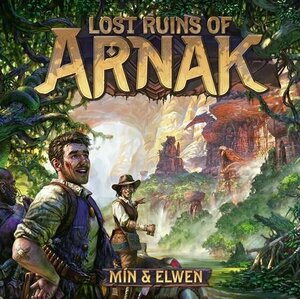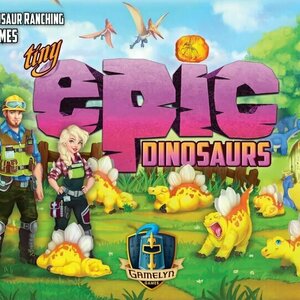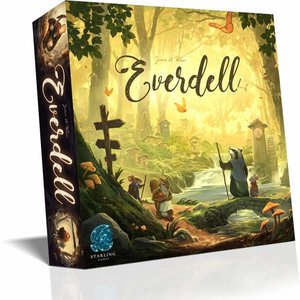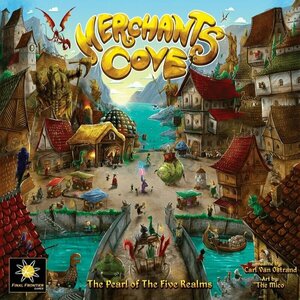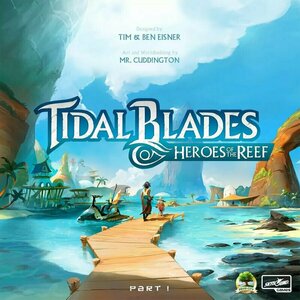
Tidal Blades; Heroes of the Reef
Tabletop Game
Welcome Heroes! Many magnificent contestants have signed up for the tournament but only a handful...
Purple Phoenix Games (2266 KP) rated Lost Ruins of Arnak in Tabletop Games
Feb 7, 2021
Players, or “archaeologists” as the game coins them, will have only 5 rounds to explore as much of the board as possible, which includes a hidden temple as well as the jungle proper. At the end of the 5 rounds, players will add up all victory points they have obtained from the temple, any treasure they have left, points on any cards collected, and guardians they have overcome.
“Lost Ruins of Arnak” takes place on, well… Arnak. It’s a fictional jungle that is teeming with wild animals and guardians which keep watch over various treasures all over the expansive island, from here forward referred to as the giant game board. These guardians appear when you explore a new jungle tile for the first time. They attack only if you stay in the location longer than a turn OR if you return to the location on a subsequent turn. If you eliminate a guardian, they provide a couple victory points towards your overall total at the end of the game, and a slight bonus when collecting artifacts from other locations later. Being attacked by a guardian isn’t the end of the world, but can have detrimental effects on your personal deck of cards if you fail to overcome a guardian too many times.
While in the jungle, you may place a single meeple, or “archaeologist” on your turn to discover a new area, or visit a previously discovered one. These new areas contain a guardian and some sort of gold amount or trinket (idols, artifacts, or jewels). These items can be used to push your token further through the hidden temple (see below) OR to purchase cards to improve your play deck going forward. While navigating this mysterious jungle can seem exciting at first glance, you have to be careful not to let your gold fever take over, as it may leave you with minimal points by not using some worker placement to explore the mysterious temple ruins further.
While the jungle takes up a majority of the board, there is a temple which players navigate through simultaneously on the right hand side of the giant board. While it isn’t as visually appealing as the jungle portion of the board, it serves by far the highest purpose by scoring victory points. As your token travels through this temple, more and more treasure (victory points) await. It is not suggested in the rulebook, but should be noted that failing to spend ample treasure to work your way through the temple is almost a sure-fire means of not having a chance to win the game. The mechanic of exploring the temple is unique, but can be costly in terms of managing your resources properly. In my opinion, this takes away from the luster of traversing through a hidden temple and finding as much fat loots as possible. Rather, it feels like another board game I own, where you are furiously chucking dice just trying to get through with no time to look around.
The final mechanic of the game, which, as I read reviews myself prior to purchase, thought would be more prominent, is the deck building mechanic. You are provided a few cards at the start, which is similar to most any deckbuilding game. These basic cards are your first few resources to use for traveling around the board OR for their monetary value in either gold or scrolls. Using the cards for travel allow you to explore different levels of the jungle on the game board. The lower areas of the board require less travel points, while the more lucrative spaces higher up in the jungle require more. To get more travel points, you will need better cards from the decks provided. By using your gold, also an aspect of each card, you may purchase stronger cards from the supply. So, there is a balance you must find between using your cards for travel or for purchases each turn. This can be very limiting with only having the 5 rounds in which to play.
My final thoughts: I am a total sucker for pretty much anything that says the words “deck building” on them, and this game was no exception. I went into this game thinking there was going to be this new way of using a deck building mechanic to also explore a really well crafted game board. I could not have been more wrong. The deck building aspect got so lost in the other mechanics, that I felt like I rarely had the opportunity to actually build my deck. After 3-4 plays of this game, with varying player counts from 2-4, I always ended up with a deck no bigger than about 15-20 cards. When I think deck build, I think of those powerhouses like Marvel Legendary, Ascension, or Star Realms where you are really transforming your deck into a large deck by the end. On top of that, most highly regarded deck builders require you to strategize somewhat in which cards that you buy to compliment your current deck further. Arnak completely leaves both of these elements out. Most times I found myself only able to purchase 1 card in the supply due to lack of resources that I did not have any choice in how that card would compliment my deck or not. It was merely just collecting a card to try and give my deck any sort of a distinct advantage going forward. Now, don’t get me wrong, like the game board, the artwork on the cards is stunning. By far this saves the poor mechanism of the actual cards themselves.
To me, the amount of mechanisms in the game is what gets in its own way. Its that classic, everything but the kitchen sink expression. The exploration gets in the way of the deck-building, which gets in the way of the worker placement, which gets in the way of the resource management. When I found myself wanting to build my deck, it was more crucial that I move up the temple one step. When I wanted to move up the temple, I was missing a certain idol, so I had to resort to wasting cards for gold to purchase a card for my deck that I really didn’t want. So while I think the premise is really thrilling for what this game could have been, in my opinion it just fell short. I left me wanting to explore the upper part of the jungle I never got to. I left me wanting to look at more of the artwork on the cards I never was able to purchase. In the end, I made it to the top of the temple. I couldn’t wait to enjoy my heaping pile of fat loots that awaited my studded archaeologist. However, once I turned over the treasure token, I only acquired another measly 12 victory points. This feeling left me wanting more from this game that was so hyped for its gameplay. I no longer felt like Indiana Jones, and more like I was in a bad B movie hoping for a better acting career.
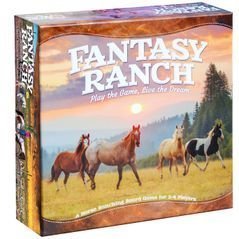
Fantasy Ranch
Tabletop Game
Welcome to Fantasy Ranch! Kick off your boots and pull up a chair for a game where all your dreams...
Purple Phoenix Games (2266 KP) rated Tiny Epic Dinosaurs in Tabletop Games
Jul 13, 2021
Tiny Epic Dinosaurs (TEDinos) is the latest release in the Tiny Epic line from Gamelyn Games and is a worker placement game of dinosaur enclosure, husbandry, and contract fulfilling for up to four enterprising ranchers. Players will be acquiring dinosaurs and barriers, feeding them, breeding them, and attempting to fulfill public and private contracts for maximum VP gains.
DISCLAIMER: I will be presenting this as a Solo Chronicles, where I will be using the Solo Rules included in the TEDinos rulebook. Also, I will not be covering every rule, as there are just too many to describe, but will give a general flow and feeling of the game to help inform your purchasing decision. -T
To setup TEDinos, follow all setup rules in the rulebook until you have something that looks like the photo above. All of the setup, save a few steps, is exactly like setting up for a multiplayer game, and the solo player will be playing the game exactly as if it were multiplayer.
The game lasts six rounds and each round is comprised of seven phases. The phases contain actions to be taken like Collect Resources (plants, meat, and supply boxes), Assign Ranchers (the meat of the worker placement game where your rancheeples and Lead Tomvaseleeple will be placed on action spaces), Retrieve Ranchers (to use them again next round), Arrange Ranch (to place your dinos in different enclosures), Feed Dinosaurs (obvious), Breed Dinosaurs (every like pair of dinos make a like dino), Refresh for Next Round (resetting card stacks and offers).
Again, I won’t go into detail about these phases, but will detail how the solo game differs a bit from the multiplayer. The Rival Rancher (AI player) will be taking actions in the second phase of every round, Assign Ranchers, but will do it using a card deck specific to the Rival Rancher. Initially the Rival Rancher will be 1st Player, so they will play a card from their deck during Assign Ranchers that will claim all of the action spaces on one of the Action Mats and give them a dineeple. For the player, should they wish to claim a spot on the same Action Mat that the Rival Rancher is sitting on, it will count as a meeple being there, so the player will need to expend their Lead Rancher or two normal Ranchers to claim a space.
This simulates another player claiming a space prior to the player’s turn, and spaces are still available, but with the added challenge of holding the Rival Rancher’s meeple. Play continues in this fashion until the end of the sixth round where player and Rival Rancher alike will add up VP to determine the winner.
Components. Like all Tiny Epic games, there are a TON of components packed into a tiny box. That is both a great thing and a challenging thing. TEDinos takes up about half of my dining table when all setup and played. So it does sprawl a little. However, many of the components are very very small and for big oaf-hands, the pieces can be fragile and cumbersome. It looks great on the table as the color palette used is fantastic (especially against a purple play surface), and the art is superb. All the components are great quality, but the meeples suffer a bit as they are so small; my copy came with several dineeples being damaged or headless or tailless or legless. That doesn’t necessarily bother me too much so I won’t bellyache about it. All in all the components are what we now expect from the Tiny Epic line.
The solo gameplay is really good and really REALLY difficult. I feel that if you don’t go into the game with a strategy ready to go you will flounder and be overwhelmed by the prowess of the AI Rival Rancher. I was the first time and I thought I would never be able to even come close to winning. But, the more I play the more I recognize different tactics to use in-game to help benefit my ranch effectively. Each AI player can use a different mat that offers different AI strategies and those are found on the back of the normal multiplayer mats. This is a phenomenal idea and offers great replayability, even for the solo plays.
Though the solo rules of TEDinos allow the AI player to be super tough, I find this to be one of the best in the Tiny Epic line. Tiny Epic Galaxies may still be my favorite, but I think TEDinos might be right behind. I can’t wait until this dino dropping-like virus is eradicated so I can play with my homies again, because I will certainly be pulling this one out quite a bit. I keep a spreadsheet of all my games in order of preference, and I admit that TEDinos has easily whomped its way into my Top 100, but will it get to Top 10 Games of All Time along with Tiny Epic Galaxies? I don’t know. Want to play and find out where it lands with you? Pick up a copy and have at it!
PS – I’m not one to shout out to other reviewers usually, but if you get a chance, do check out the Watch It Played video of this one. Rodney does a great job (as always) and helped me clear up some questions I had after reading the rule book.
Purple Phoenix Games (2266 KP) rated Millennial Manatees in Tabletop Games
Mar 11, 2021
Millennial Manatees is a worker-placement(ish) card(ish) game for one to four players. In it players are assuming roles of manatees tasked with paying off their identical student loan debt: 20 coins. The first player to make wise venture investments and create the best ROI will be crowned the winner! Please keep reading. This game is not at all a powerhouse economic simulation. It’s a fun game with manatees, avocado toast, and IT COMES IN A FANNY PACK.
DISCLAIMER: We were provided a copy of this game for the purposes of this review. This is a retail copy of the game, so what you see in these photos is exactly what would be received in your box fanny pack. I do not intend to cover every single rule included in the rulebook, but will describe the overall game flow and major rule set so that our readers may get a sense of how the game plays. For more in depth rules, you may purchase a copy online directly from the publisher (or Amazon if you wish) or from your FLGS. -T
To setup carefully empty the contents of the fanny pack game box(?) and unfold the game board. Upon it will be placed separated (but shuffled) face-up decks for Basic, Salty, and Big Mood venture cards. Next to these shuffle the Volunteer cards and place the deck face-down. Shuffle the remaining Manatee cards and place somewhere around the game board. Each player chooses a color of manatee and takes all the components matching its shirt color. Unlike the photo below place all “fanatee pack” tokens with the 7 coins side face-up and each player will start the game with three coins. The players will set their debt trackers at the starting position of the debt track, and the first player receives the avocado toast token. Yes, the big one you see below.
Each round begins with the avocado toast holder and continues around the table. The first player will place their manateeple (ooh I like that one) on any card or printed space on the game board. Options include: Basic, Salty, or Big Mood venture cards, Volunteer cards, Boomer Handout board space, Take the Toast board space, and Pay Back Student Debt board space. Once the current toast holder has placed their manateeple the next player may place on any other non-occupied space or card available. Note: the Pay Back Student Debt space is always available for any number of manateeples.
For the cost in coins printed on the cards, the Basic, Salty, and Big Mood venture cards can be purchased and placed in the player’s tableau of cards. This represents the player investing in certain business ventures in the hopes of earning more coins in the long run. Once a player has a venture card in front of them the card will specify how it will be activated and the benefit therein. Many cards allow the player to collect coins, but sometimes cards allow for stealing of other players’ coins or other nefarious doings.
The volunteer cards are drawn face-down and once read by the drawing player are kept face-down in their tableau until the proper game phase activates it or the player plays it to the discard pile.
Once a player decides they want to pay down their debt they will visit the Pay Back Student Debt space on the board. When they do this they will immediately use ALL coins they have earned and apply it directly to their debt by moving their tracker down the line by the amount paid.
By placing the manateeple on the Take the Toast space, that player simply takes the toast token and becomes the first player of the next round. By placing the manateeple on the Boomer Handout space the player will gain one coin during the Manatee phase.
The Manatee phase consists of the first player flipping the top card of the Manatee deck. Most of the cards in this deck are art depictions of manatees in different attire and hairstyles. When a Manatee card is flipped during this phase, all players reference any venture cards in their tableau to see if the manatee will trigger their card. For example, a manatee may be dressed in an orange shirt, wearing sunglasses, and holding a yoga mat. For those players whose venture cards are triggered by any of these items, their cards will bestow their benefits. There are two other types of cards in this deck as well, but I will let you experience these when you play.
Turns continue in this fashion of placing manateeples in unique spaces or cards, resolving any immediate effects, playing volunteer cards, flipping and resolving Manatee cards, and paying down student debt until one player has paid off the entire sum and wins the game! Then the hardest part of the game will commence: attempting to put all the components back in the fanny pack so that they are not damaged. Good luck.
Components. This game has some pretty spectacular components coupled with some really great art. Obviously, having a game packaged in a fanny pack is just delightful, even though I typically despise non-boxed games. Secondly, all the wooden manateeples and avocado toast tokens are just amazing to behold and handle. The cards are good quality and the game features incredible art throughout. I am a big fan of this art style – it is very cartoony and very cool. This theme is just perfection and the game that lies beneath the theme is very surprising.
I say the game beneath the great art and theme is surprising because I was completely not expecting to like this one as much as I do. At its heart it is a very light worker-placement game with hints of take that and based on using currency as victory points. I like all of those mechanics quite a bit, so combining these with aforementioned art and theme works for me on another level.
I feel this game is something I can bring out with almost any crowd of adults and have a smashing great time. There are so many little jokes packed into this little game that make me giggle every time I see them. And come on, a first player token that is avocado toast? It’s too good! I love all the colors assaulting my eyes, and I love all the hate-placement that happens, and I didn’t know that I love manatees as much as I now do.
Look, I am usually pretty positive about the games I play. But I also play a lot of stinkers. This one, thankfully, delivers a super fun game experience in an hour or less, even though the theme is absolutely ridiculous. But I also find that so charming. If you are looking for that special WOW game that is relatively light but incredibly satisfying to play, I strongly recommend checking out Millennial Manatees. Purple Phoenix Games gives this one 10 / 12 soy super americanos (is that a thing?). Display the pink fanny pack with pride next to all your super-serious games and watch as your visitors flock to it and ask what it is. Then play it with them and watch them fall in love as we did. I am very happy to now have this one in my collection.
Purple Phoenix Games (2266 KP) rated Everdell in Tabletop Games
Jun 12, 2019
As in all my reviews I am not going to explain the entire game. There are videos for that. There are digital scans of the rulebook for that. I’m going to give you my impressions and opinions on the games I played.
Disclaimer: We are reviewing the vanilla Everdell retail edition. We do not have plans to review the Collector’s Edition, but if we get our paws on a copy, we will update this review with its information. Same goes for the Pearlbrook expansion. -T
So I am going to start off with the negatives: the font on the cards. I understand why they made the font so small – they wanted to highlight as much of the gorgeous art as possible. So everything gets shoved to the sides of the cards and subsequently gets smushed in the process. That makes for a very difficult time trying to read the cards and the abilities and the chaining card names. That certainly put a hamper on Bryan’s experience with the game, and that’s a big big reason he has it at a 3. It’s near unplayable for him for that matter. I told him to put on his big-boy glasses, but, you know, younger brothers and all…
However, the gameplay is where it’s at with this one. The worker placement is excellent, with great choices every turn, even when Laura monopolizes the pebble space. The chaining cards a la 7 Wonders is familiar and they make sense – the Innkeeper goes with the Inn, etc. The gameplay is fluid and after a round or two we all “got it” and the game became quite fun. The components are incredible – even with the retail version we played we got those awesome little squishy berries. The theme is so stinkin cute with all the woodland creatures, and paired with the incredible art and components I was mesmerized. The game did not wear out its welcome, nor was it too quick. It was just right. I will definitely be pulling this one out much much more over the year, and I hope to convince Bryan and Josh that it’s better than their first play.
We at Purple Phoenix Games are all over the place with this one, awarding it a score of 18 / 24.
https://purplephoenixgames.wordpress.com/2019/02/15/everdell-review/
Peter Shephard (2822 KP) rated Merchants Cove in Tabletop Games
Jun 4, 2021
The pieces (ships, meeples, and individual gaming boards) are fantastic (although a couple are a little fiddly/weak) and every single character has their own flavour and type of sub-game;
The Alchemist makes potions by drawing marbles, firstly from a bag, then from a "decanter" (echoes of Quacks of Quiddlingberg)
The Blacksmith makes weapons and armour from dice rolls and combos in furnaces (not quite Yahtzee)
The Captain sails her fleet of ships to go fishing and treasure hunting using a spinning compass mechanism (can't put my finger what this reminds me of)
The Chronomancer (a great Back to the Future nod) travels through time portals to get pieces of technology, using a slide-and-shift board (like a mini Labrynth)
The Dragon rancher (believe it or not) hatches, raises and sells dragons; a couple of mechanics which work well together (even if one is shovelling poop) but not really like a game I've played
The Innkeeper is a great sub-sub-game; he can only sell drinks at one point, but he can put people up in his Inn which gives a bonus. A little bit of prediction work, but not like a other game I can think of.
The Oracle uses a scatter/dish for her fetishes and dice, and this limits what she can do - but I'd say she has the most varied scope of games (dots, predictions, and a few others)
The aim of the game is to be the Merchant who makes the most money, without attracting too much Corruption. Each game is played over three days, and each day has a limited amount of time. Each task the characters do has a different amount of time-cost - it might take 1h to brew potions, but it takes 2h to get ingredients from the decanter and prepare the potions. At several points each day, random Adventurers are drawn from the bag, and put into the travelling ships, as chosen by the drawer. However, there are also rogues who take up space and don't buy anything!
My only real complaint with the game is the comparatively long set up (5-10 minutes seems to be our average) for a 30-45m play time for 2 players - but it is really worth it. If/when this goes to retail, I'd say every gaming group who enjoys a combination of resource management, meeple and worker placement, and beautiful set-piece games, should give this a try.

Ticket to Ride: First Journey
Games
App
"***It looks like Days of Wonder has come up with a solution to my problem with the introduction of...
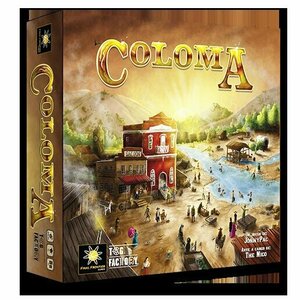
Coloma
Tabletop Game
Coloma is the town where an unexpected event happened that shaped history of the Western Frontier....
Boardgames WildWestgames 2019Games

Lowlands
Tabletop Game
The low land is a rough area where hard-working folk make a living by the sweat of their brow. Under...
BoardGames 2018Games FarmGames
